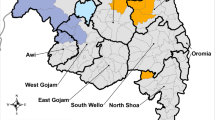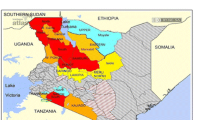Abstract
To determine prevalence and risk factors of trachoma in communities receiving intervention with the SAFE strategy (surgery, antibiotic, face washing, environmental hygiene), a cross-sectional trachoma survey was undertaken in 2006 in the Enemor district of southern Ethiopia where the SAFE program has been implemented for over five years. A sample of 374 household heads and 2,080 individuals were interviewed and examined for trachoma using an established trachoma grading system of the World Health Organization. The most prominent risk factors were identified with logistic regression analysis. Among individuals >14 years of age, the prevalence of trichiasis was 9.04 % [confidence interval (CI) 7.4–10.6]. People >40 years of age [odds ratio (OR) 1.7; CI 1.2–2.7), women (OR 2.2; CI 1.1–4.3), and illiterates (OR 3; CI 1.4–6.8) had increased risk of trichiasis. Coverage of surgical and antibiotic services was 46 and 85.5 %, respectively. Prevalence of active follicular trachoma (TF) in children aged 1–9 years was 33.1 % (CI 29.4–37.1). Unclean faces (OR 5.9; CI 4.3–8.3) and not being in school (OR 2.1; CI 1.3–3.3) were significantly associated with TF. Clean faces were observed in 56.1 % of children and improved with age and schooling (P < 0.001, Chi-squared test). Household latrine use (74.4 %) was associated with knowledge about SAFE and economic level (P ≤ 0.004, Chi-squared tests). Elderly illiterate women remain at risk of becoming blind from trachoma even in intervention areas. Trachoma particularly affects children without clean faces or opportunity for schooling. Provision of SAFE services with high coverage should be sustained in trachoma-hyperendemic areas.
Similar content being viewed by others
References
Mariotti SP, Pascolini D, Rose-Nussbaumer J (2009) Trachoma: global magnitude of a preventable cause of blindness. Br J Ophthalmol 93:563–568
Polack S, Brooker S, Kuper H et al (2005) Mapping the global distribution of trachoma. Bull World Health Organ 83:913–919
Resnikoff S, Pascolini D, Etya’ale D et al (2004) Global data on visual impairment in the year 2002. Bull World Health Organ 82(11):844–851
Negrel AD, Mariotti SP, Thylefors B (1997) World Health Organization alliance for the elimination of trachoma. Rev Int Trach Pathol Ocul Trop Subtrop Sante Publique 74:109–117
Mabey DC, Solomon AW, Foster A (2003) Trachoma. Lancet 362(9379):223–229
Kasi PM, Gilani AI, Ahmad K, Janjua NZ (2004) Blinding trachoma: a disease of poverty. PLoS Med 1(2):e44
Cumberland P, Hailu G, Todd J (2005) Active trachoma in children aged three to nine years in rural communities in Ethiopia: prevalence, indicators and risk factors. Trans R Soc Trop Med Hyg 99(2):120–127
Cromwell EA, Courtright P, King JD, Rotondo LA, Ngondi J, Emerson PM (2009) The excess burden of trachomatous trichiasis in women: a systematic review and meta-analysis. Trans R Soc Trop Med Hyg 103(10):985–992
Wondimu A, Bejiga A (2003) Prevalence of trachomatous trichiasis in the community of Alaba District, Southern Ethiopia. East Afr Med J 80(7):365–368
Hsieh YH, Bobo LD, Quinn TC, West SK (2000) Risk factors for trachoma: 6-year follow-up of children aged 1 and 2 years. Am J Epidemiol 152(3):204–211
Alemayehu W, Melese M, Fredlander E et al (2005) Active trachoma in children in central Ethiopia: association with altitude. Trans R Soc Trop Med Hyg 99(11):840–843
Ngondi J, Onsarigo A, Adamu L et al (2005) The epidemiology of trachoma in Eastern Equatoria and Upper Nile States, southern Sudan. Bull World Health Organ 83(12):904–912
Mesfin MM, de la Camera J, Tareke IG et al (2006) A community-based trachoma survey: prevalence and risk factors in the Tigray region of northern Ethiopia. Ophthalmic Epidemiol 13(3):173–181
Ngondi J, Onsarigo A, Matthews F et al (2006) Effect of 3 years of SAFE (surgery, antibiotics, facial cleanliness, and environmental change) strategy for trachoma control in southern Sudan: a cross-sectional study. Lancet 368(9535):589–595
Ngondi J, Gebre T, Shargie EB et al. (2009) Evaluation of three years of the SAFE strategy for trachoma control in five districts of Ethiopia hyperendemic for trachoma. Trans R Soc Trop Med Hyg. Published online first: 27 Jan 2009. doi:10.1016/j.trstmh.2008.11.023
Berhane Y, Worku A, Bejiga A, Adamu L et al (2007) Prevalence of trachoma in Ethiopia. Ethiop J Health Dev 21(3):211–215
WHO (2006) Trachoma control: a guide for program managers. World Health Organization, Geneva
Thylefors B, Dawson CR, Jones BR et al (1987) A simple system for the assessment of trachoma and its complications. Bull World Health Organ 65:477–483
Morrisa SS, Carlettoa C, Hoddinotta J, Christiaensenb LGM (2000) Validity of rapid estimates of household wealth and income for health surveys in rural Africa. J Epidemiol Community Health 54:381–387
Emerson PM, Ngondi J, Biru E, Graves PM, Ejigsemahu Y et al (2008) Integrating an NTD with one of “The big three”: combined malaria and trachoma survey in Amhara Region of Ethiopia. PLoS Negl Trop Dis 2(3):e197
Rabiu MM, Abiose A (2001) Magnitude of trachoma and barriers to uptake of lid surgery in a rural community of northern Nigeria. Ophthalmic Epidemiol 8(2–3):181–190
Lakew T, House J, Hong KC, Yi E, Alemayehu W et al (2009) Reduction and return of infectious trachoma in severely affected communities in Ethiopia. PLoS Negl Trop Dis 3(2):e376. doi:10.1371/journal.pntd.0000376
West SK, Munoz B, Mkocha H et al (2007) Trachoma and ocular Chlamydia trachomatis were not eliminated three years after two rounds of mass treatment in a trachoma hyperendemic village. Invest Ophthalmol Vis Sci 48(4):1492–1497
Schémann J-F, Sacko D, Malvy D et al (2002) Risk factors for trachoma in Mali. Int J Epidemiol 31:194–201
Sallam TA, Raja’a YA, Al-Zubiery TK et al (2003) Chlamydia trachomatis infections among Yemeni school pupils in relation to environmental conditions. Saudi Med J 24(1):84–87
Courtright P, Sheppard J, Lane S et al (1991) Latrine ownership as a protective factor in inflammatory trachoma in Egypt. Br J Ophthalmol 75(6):322–325
Lee DC, Chidambaram JD, Porco TC et al (2005) Seasonal effects in the elimination of trachoma. Am J Trop Med Hyg 72:468–470
Acknowledgments
This work was financially supported by the Association of Physicians of Great Britain and Ireland, and Thomas Spence Dunn Trust. We acknowledge the cooperation of the Enemor and Ener District Health Office, Gurage Zone Health Desk and ORBIS International-Ethiopia Office for facilitating the study.
Conflict of interest
None of the authors has financial conflict of interest in this study. Sponsors had no role in the design, implementation or publication of the research work.
Author information
Authors and Affiliations
Corresponding author
Rights and permissions
About this article
Cite this article
Roba, A.A., Patel, D. & Zondervan, M. Risk of trachoma in a SAFE intervention area. Int Ophthalmol 33, 53–59 (2013). https://doi.org/10.1007/s10792-012-9632-3
Received:
Accepted:
Published:
Issue Date:
DOI: https://doi.org/10.1007/s10792-012-9632-3




